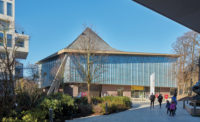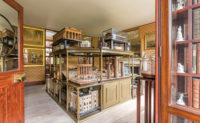“Simplicity,” says John Pawson, “allows us to focus on the things that matter.” The British architect's “minimalist” renovation of the Catholic church of St. Moritz in Augsburg, Germany, embodies that idea. Stark white walls, a pale limestone floor, and finely crafted oak joinery give a harmonious expression to the diverse parts of a building formed in a thousand-year process of addition and subtraction, but also serve the project's greater purposes: to strengthen the connection between the architecture and the rituals of the church, and to engender a sense of the sacred.
For morning Mass, daylight from the apse and clerestory windows provides sufficient illumination with minimal assistance from the recently installed lighting fixtures. Bright sunlight-filled windows lead visitors to perceive that the room itself is bright, says project architect Jan Hobel. “By indirectly lighting the walls of the nave so that its surfaces appear brightly lit, we can enhance that perception, and therefore need a lower level of illumination overall.”
The effect of light on the perception of space is also used to direct the attention of the congregation toward the altar in the chancel, in accordance with the church's liturgical principles, and give a sense of proximity to the proceedings. From the pews in the nave, the relatively dark side aisles recede from consciousness, as does the choir, which is situated between the congregation and the radiant apse, giving greater prominence to a figure of Christ that stands in isolation, bathed in light.
Working in collaboration with the London-based lighting design firm Mindseye, the architect devised a scheme that adjusts to change the perceived shape of the space to suit the variety of events taking place in the course of the liturgical year. The control system offers over 30 distinct “scenes.” For ordinary evening services, floor-recessed LEDs highlight the columns with warm white light to make the nave feel “narrow and cozy,” explains lead lighting designer Admir Jukanovic, while for larger celebrations, the whole space is brightly lit, revealing its more flamboyant Baroque-inspired domes and high windows. At the end of the Mass, another “scene” illuminates the west wall, subtly drawing the congregation toward the exit. Afterward, the church is open to the general public, and light levels rise in the aisles to encourage strollers to explore its collection of statues, now housed in backlit niches on the side walls.
As magicians know, we are fooled by illusions whose preparation requires more effort than the onlooker would ever suspect. At St. Moritz Church, the use of light to set the mood or direct traffic is enabled by an impressive array of technology—effective because of the lengths to which the designers have gone to conceal it. Hidden LEDs project vivid halos around the shallow vaults above the nave. Functional task lighting for activities below comes from metal halide luminaires secreted behind existing 5-inch vents in the vaults' plaster shells. They provide levels of 200 lux onto the pews—enough to read by. At the eastern end of the building, where more light is required, the narrow lenses of nine halogen projectors are directed through newly made apertures in the vault above the altar, hidden from view by an upturned cornice.
Equal care is taken to control how and where light falls. LED wall-washers illuminating the arches that span the nave have been adapted to prevent any spill onto the wall behind. This same attention to detail is evident in the handling of the small rooms accessed from the aisles. In the Sacramental Chapel, horizontal light slots guide the eye to a crucifix framed by an arc of light that spills from the junction between walls and vaulted ceiling, while, in the baptismal chapel, the font sits beneath an oculus that opens onto an illuminated dome suggesting infinite space above.
Such a quietly potent fusion of light and architecture quickly disproves the first impression of homogeneity conveyed by its minimalist color and material palette. That Pawson is able to speak of this rich, technically sophisticated project in terms of its simplicity is, perhaps, the measure of its success.
PeopleFormal name of building: Location: Completion Date: Gross square footage: Total construction cost: Client: Owner: Architect: Personnel in architect's firm who should receive special credit: Engineers: Consultant(s): Photographer: Lighting Designer: Mindseye Lighting Size: 20,000 square feet Cost: withheld Completion date: April 2013 |
ProductsLighting Wall washers: Edge lighting: Control system: Other lighting components used in the project: Stonemason: Stone restoration: Lights: Carpenter: Church Windows: Organ: Stucco and plaster: Painter: Metal Artwork: Heating: |
















Post a comment to this article
Report Abusive Comment